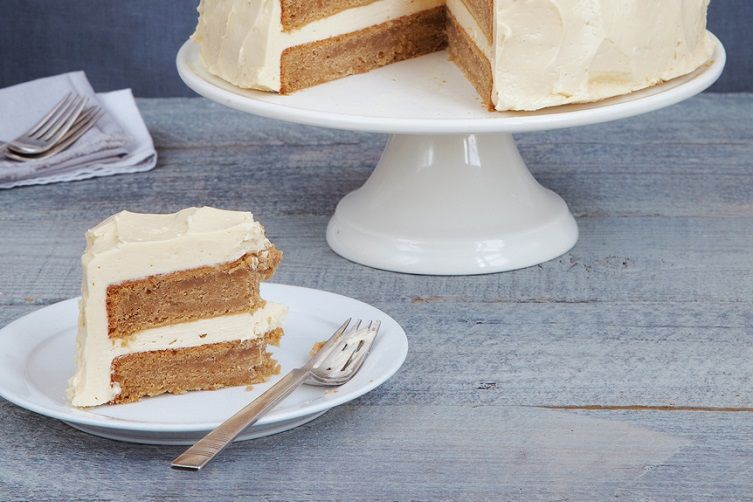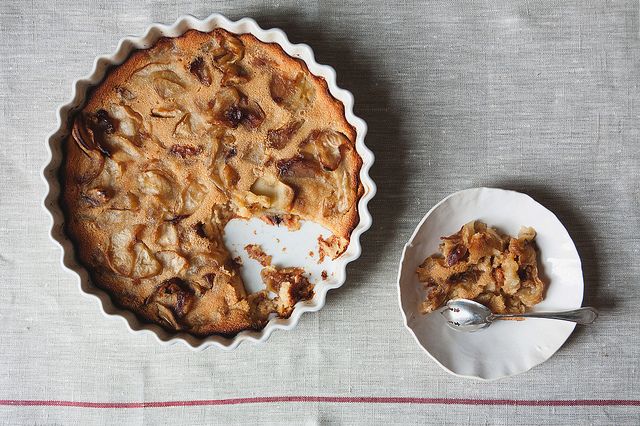We're sitting down with our favorite writers and cooks to talk about their upcoming cookbooks, their best food memories, and just about anything else.
Today: Pastry chef Jenny McCoy discusses kitchen disasters, the perfect weeknight dessert, and why it's okay to play it fast and loose, even in pastry. Plus, we're giving away three copies of her book!

We're all guilty of it: buying those jewel-like, ruby-red raspberries in December, even though we know they'll never be as delicious as they were during their summer peak. And while quality ingredients are the cornerstone of quality cooking, when it comes to dessert, seasonality makes all the difference.
This emphasis on seasonlity shapes Jenny McCoy's new cookbook, Desserts for Every Season. Working as a pastry chef under culinary greats like Emeril Lagasse and Tom Colicchio, she learned that the best desserts are the simplest ones. Jenny's philosophy is that if you use high-quality, seasonal ingredients, they will naturally produce a high-quality dessert -- and give you room to improvise. This is why her cookbook is divided up not into cakes, cookies, and pies, but into spring, summer, and fall. She even throws in a handy-dandy harvest calendar, and includes which fruits you can use all year long (thank you, Hawaii). Now your desserts can take a trip to the farmers market when they need to, and stick to the grocery store when they don't.
It’s a Wednesday night and you really need something sweet. What’s your go-to quick fix dessert?
Honey-roasted fruit with vanilla ice cream or whipped cream. Sometimes I’ll throw some chopped nuts or granola over top. Just slice any in-season fruit you have on hand, toss it with a little cinnamon, some sugar, a drizzle of honey, and a pinch of salt, and spread the whole thing in an olive oil-greased baking dish. Pop into a 450° F oven, and twenty minutes later, dessert is ready!
More: This Milk Stout Cake may take a bit more time, but it's worth every second.

You write that it’s okay to take risks and to “trust your instincts,” which is not something you typically find in detail-oriented baking books. Why the flexibility?
I find home bakers, and even some professional pastry chefs, believe that one must follow everything by the book. To me, that’s just not very fun or inventive. I like to play around in the kitchen and when I’m baking a new recipe, I try to make it my own, which is why I encourage bakers to take risks -- whether that is swapping ingredients, or turning off the timer and taking your baked goodies out of the oven when you know they’re ready. The first pastry chef I worked for wouldn’t let me use a timer, so I’d develop an internal clock. And new cooks in my pastry department would look at me in horror when I told them there was no recipe for my fruit sauces, that I would just make them to taste. I think I approach baking a little more like a savory chef. Less rules equals more creativity.
Do you think your Southern heritage has informed your baking philosophy?
I think that’s probably where my more laissez-faire approach to baking takes root; my family is a very easy-going bunch. When I worked with Emeril in New Orleans, one of the line cooks used to say “that’s Cajun” whenever something was burnt to a crisp. I always thought that was hilarious, and try to take that philosophy into my kitchen. Cooking and baking is a means to have fun. It’s supposed to be enjoyable -- for the chef and those who get to savor the results. Being Southern seems to make it easier to not sweat the small stuff and let les bon temps rouler…
What’s one long-forgotten dessert you want to bring back en mode?
Clafoutis or Charlotte Russe -- they are two of my favorite desserts. The first is so simple to make that I don’t know why it isn’t more popular. And Charlotte Russe is a dessert that I’ve been eating since I was a little girl. It is made with a sherry mousse that is surrounded by ladyfingers. Now that sherry seems to be making an appearance on more cocktail menus, I hope it will find its way in desserts, too.
More: A clafoutis is sounding pretty good right now...

Do you have any baking disaster stories to share?
I have so many stories of disaster that I like to say my cooks spent more time putting out my fires than making my desserts! Currently, I’m working with a large commercial bakery to develop new recipes. About a month ago, we were testing one of my creations. My team and I made a 100-pound batch of cookie dough with salt instead of sugar. So you see, it can happen to anyone!
Oh, and don’t tell Tom Colicchio, but I accidentally dropped about ten pounds of melted chocolate on the hardwood floors in the Craft private dining room. It took quite some time to clean up, but the wood is now sufficiently oiled for years…
Milk Stout Cake and Malted Milk Buttercream
Makes one 8-inch, two-layer cake
2 1/2 cups unbleached all-purpose flour
1 1/2 teaspoons baking soda
1/2 teaspoon fine sea salt
3/4 teaspoon ground ginger
3/4 teaspoon ground cinnamon
Pinch cayenne pepper
8 ounces (2 sticks) unsalted butter, softened
1/4 cup granulated sugar
3/4 cup packed light brown sugar
2 tablespoons molasses
1 large egg
One 12-ounce bottle of milk stout beer, at room temperature
Nonstick cooking spray
See the full recipe (and save and print it) here.
We're giving away 3 copies of Desserts for Every Season! To win a copy, comment below: what's your favorite seasonal dessert? Or, do you have a go-to sweet that can be made anytime, anywhere? We'll pick winners at random at the end of the week! (Unfortunately, we can only ship domestically).
Photo of Jenny with her book form The Kitchn; photo of cake by Pernille Pederson; photo of clafoutis by James Ransom.





See what other Food52 readers are saying.